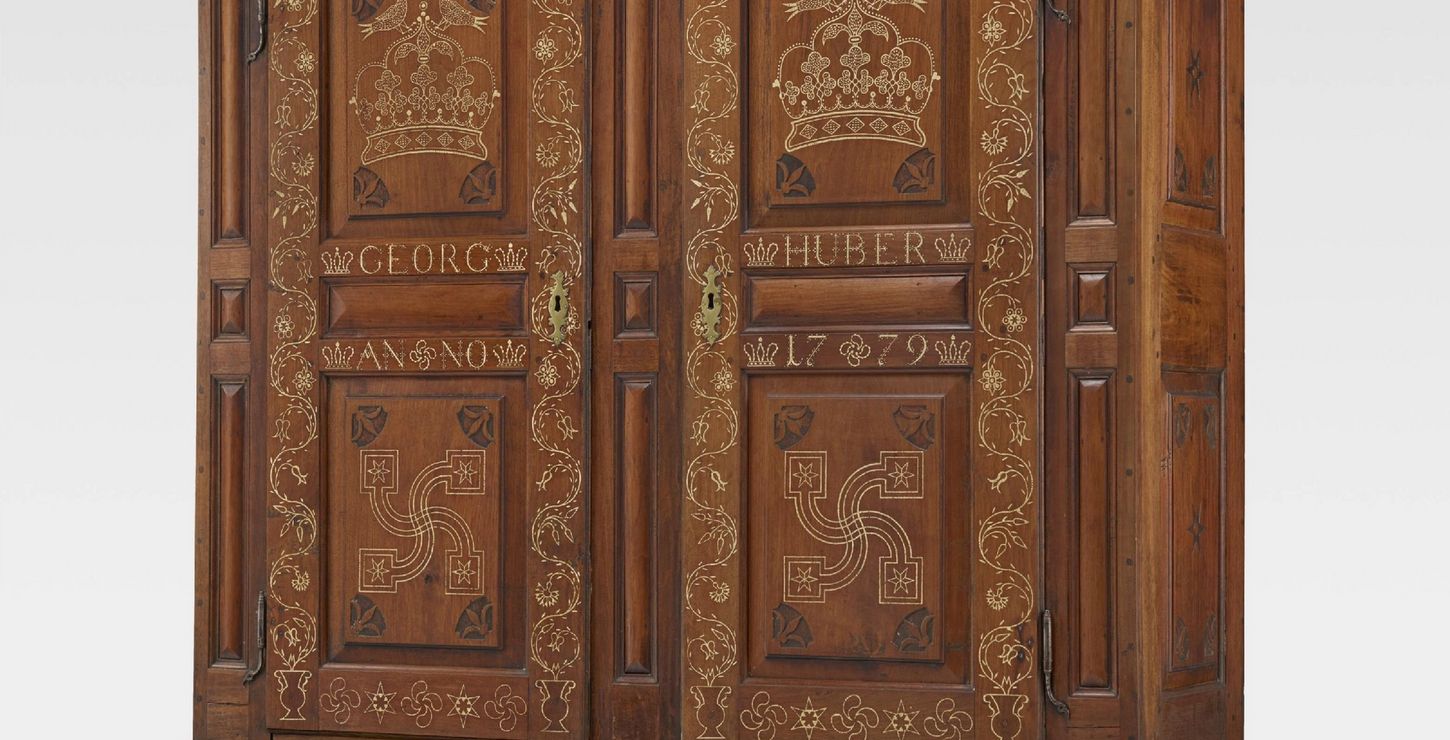Main Building
German-speaking peoples began to arrive on these shores in 1682 with William Penn, drawn by the promise of religious liberty and economic opportunity. Known world-wide as the Pennsylvania Dutch, they brought with them the artistic traditions of such regions as the Palatinate in southern Germany, the Netherlands, Switzerland, Austria, Northern Germany, Moravia in Czechoslovakia, and Silesia in Poland. The diversity of their backgrounds contributed to the rich variations in their colorful, well-crafted furniture, books and manuscripts, and household objects in metal, glass, woven fabrics, pewter, and ceramics. The rich red clay of southeastern Pennsylvania was quickly exploited by the Germanic immigrants to produce plates and pots decorated and inscribed with slip trailing and sgraffito. By the 18th century, almost every township in Montgomery and Bucks County had a pottery which was passed on from one generation to the next. While European examples doubtlessly provided the initial inspiration for designs, the Pennsylvania Germans soon developed their own decorative innovations. The strong desire, even among those with limited means, to beautify and embellish their homes made decorative plates treasured possessions, many of which carried inscriptions to do with marriage and the family. One charming example is a white-slip plate bordered in hearts with a green and brown design of a woman in skirt and bodice and a man in vest and breeches. The German phrase which comes from the woman's mouth to encircle her husband translates: "Thou hast been a dear man to me since first I ever looked at thee." Not all sayings were so harmonious, as seen in such inscriptions as "Rather would I single live than the wife the breeches give," and "I cook what I can. If my pig will not eat it, my husband will." The Pennsylvania Germans retained many Old World customs, but they were also ardent patriots and their love of liberty is often reflected in their art. They fought valiantly in the Revolutionary War and looked on George Washington as a great hero, as seen in an ink and watercolor fraktur of 1842. The artist, Durs Rudy, Jr., chose to commemorate Washington as Commander-in-Chief of the American Army and placed a liberty pole and cap on his right. The inscription above his head translates as "liberty, equality, harmony, and brotherly love." American symbols of freedom are found on many other objects, including a rare swivel barrel flintlock rifle of about 1810. The rifle was made in Philadelphia by Jacob Kuntz, whose superb craftsmanship was recognized in 1833 when he received a silver medal from the Franklin Institute. This particular rifle, with a handsome maple butt, shows the level of achievement attained by the Germans in a predominantly Anglo-American society. One of the barrels is a smoothbore, the English preference, the other is rifled, typical of German weapons, while the cheekplate bears an American eagle flanked by rampant lions. The wide range of materials represented in this exhibition has been organized around a number of themes, highlighted by The Home and The Marketplace. The first features Germanic utensils and furnishings placed in their traditional locations in a Pennsylvania German kitchen, living room, and bedroom. The Marketplace will show the products they made and sold for each other and for their English neighbors as the basis of their economic life. The Pennsylvania Germans: A Celebration of Their Arts 1683-1850 was organized by Beatrice B. Garvan, Associate Curator of American Art at the Philadelphia Museum of Art, and Charles F. Hummel, Deputy Director for Collections at Winterthur Museum and Gardens, Delaware. Over 300 objects have been selected from the organizing museums and nearly 100 other institutions and private collections. A book organized around the exhibition's themes, published for both institutions by the Philadelphia Museum of Art, contains colorplates and photographs of over one-third of the objects displayed, with essays by the co-curators. A microfiche catalogue of all the objects will be published by the University of Chicago Press. The exhibition and catalogue are supported by grants from the Du Pont Company, The Pew Memorial Trust, the National Endowment for the Humanities, The Campbell Soup Company, and the Pennsylvania Humanities Council. After leaving Philadelphia, the exhibition will travel to the Museum of Fine Arts, Houston, the M. H. de Young Museum, San Francisco, and the Art Institute of Chicago.
Organizers
Philadelphia Museum of Art
Henry Francis Du Pont Winterthur Museum, Delaware
Itinerary
Philadelphia Museum of Art
Museum of Fine Arts, Houston
M. H. de Young Memorial Museum
Art Institute of Chicago
